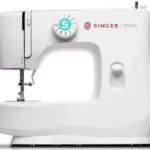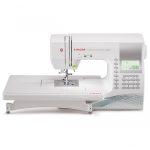
SINGER M1150 Sewing Machine Instruction Manual
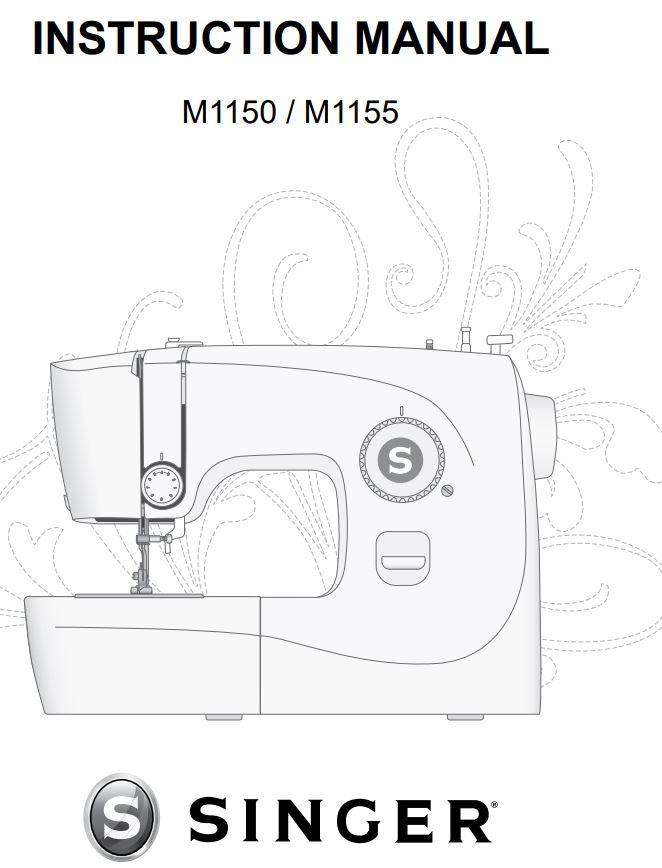
IMPORTANT SAFETY INSTRUCTIONS
Read all instructions before using this household sewing machine. When using an electrical appliance, basic safety precautions should always be followed, including the following: Keep the instructions at a suitable place close to the machine. Make sure to hand them over if the machine is given to a third party. This appliance is intended for use by adults. The appliance can be used with adult supervision by (i) children aged from 8 to 12 years and (ii) persons with reduced physical, sensory or mental capabilities or lack of experience and knowledge if they have been given instruction concerning use of the appliance in a safe way and understand the hazards involved. Cleaning and user maintenance shall not be made by children without supervision. It is not allowed for anyone to play with the machine. Children up to 8 years are not allowed to use the machine.
WARNING – TO REDUCE THE RISK OF BURNS, FIRE, ELECTRIC SHOCK, OR INJURY TO PERSON:
- A sewing machine should never be left unattended when plugged in. The electrical socket, to which the machine is plugged in should be easily accessible. Always unplug this sewing machine from the electric outlet immediately after using and before cleaning, removing covers, lubricating or when making any other user servicing adjustments mentioned in the instruction manual.
- Do not allow to be used as a toy. Close attention is necessary when this sewing machine is used by or near children.
- Use this sewing machine only for its intended use as described in this manual. Use only attachments recommended by the manufacturer as contained in this manual.
- Never operate this sewing machine if it has a damaged cord or plug, if it is not working properly, if it has been dropped or damaged, or dropped into water. Return the sewing machine to the nearest authorized dealer or service center for examination, repair, electrical or mechanical adjustment.
- Never operate the sewing machine with any air openings blocked. Keep ventilation openings of the sewing machine and foot control free from the accumulation of lint, dust, and loose cloth.
- Keep fingers away from all moving parts. Special care is required around the sewing machine needle.
- Always use the proper needle plate. The wrong plate can cause the needle to break.
- Do not use bent needles.
- Do not pull or push fabric while stitching. It may deflect the needle causing it to break.
- Wear safety glasses.
- Switch the sewing machine off (“0”) when making any adjustment in the needle area, such as threading needle, changing needle, threading bobbin, or changing presser foot, etc.
- Never drop or insert any object into any opening.
- Do not use outdoors.
- Do not operate where aerosol (spray) products are being used or where oxygen is being administrated.
- To disconnect, turn all controls to the off (“0”) position, then remove plug from outlet.
- Do not unplug by pulling on cord. To unplug, grasp the plug, not the cord.
- The foot control is used to operate the machine. Never place other objects on the foot control.
- Do not use the machine if it is wet.
- If the LED lamp is damaged or broken, it must be replaced by the manufacturer or its service agent or a similarly qualified person, in order to avoid a hazard.
- If the cord connected with the foot control is damaged, it must be replaced by the manufacturer or its service agent or a similarly qualified person, in order to avoid a hazard. For Overlock Machines only:
- Never operate without a cutter cover or a securely installed cover stitch table.
SAVE THESE INSTRUCTIONS
INTRODUCTION
Intended Use
Optimal use and maintenance are described in these instructions. This product is not intended for industrial or commercial use. Additional assistance, by region, may be found online at www.singer.com.
Machine Overview
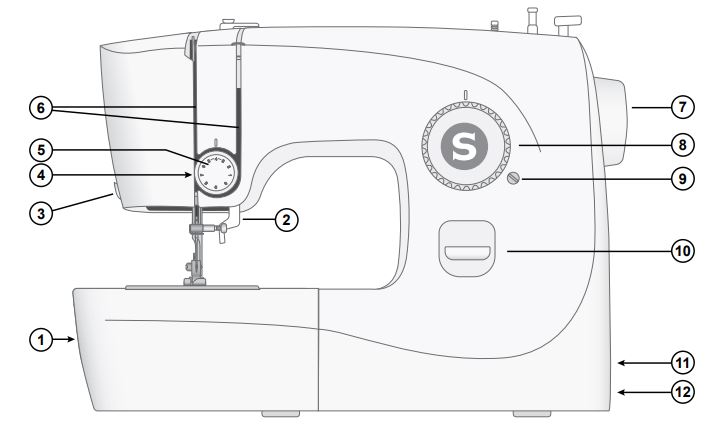
- Accessory Tray / Free Arm — provides a flat surface when sewing and allows storage for your accessories. Remove the accessory tray to use the free arm which makes it easier to sew, e.g., trouser hems and sleeves.
- Presser Foot Lifter
- Thread Knife — for trimming thread ends at the end of sewing.
- Thread Tension Disks — positioned behind the thread tension dial.
- Thread Tension Dial — adjustable for setting the desired tension for your stitch, thread and fabric.
- Threading Slots — thread paths with tension discs and take up lever.
- Hand Wheel — used to manually control the movement of the needle and the thread take-up lever.
- Stitch Selector Dial — is used to select stitch patterns and buttonhole settings (see page 12).
- Buttonhole Balance
- Reverse Sewing Lever — press and hold to sew in reverse, e.g., when securing the beginning or ending of a seam.
- Power and foot control socket
- On/Off switch
Top of Machine
- Thread take-up lever
- Bobbin winding tension disc
- Thread guides
- Handle
- Spool pin
- Bobbin winding stopper
- Bobbin winding spindle
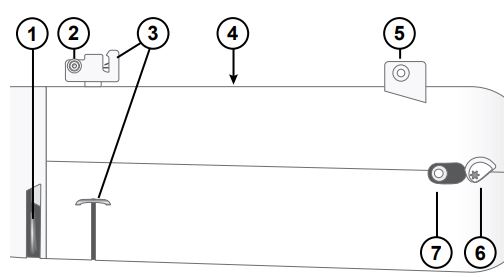
Needle Area
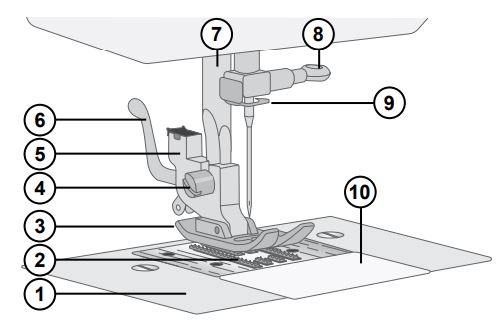
- Needle Plate — provides a flat area around presser foot for sewing. Guidelines indicate various seam allowances used to guide fabric while sewing.
- Feed Teeth — feed the fabric under the presser foot when sewing.
- Presser Foot — holds fabric against feed teeth which draw fabric under the presser foot as you sew.
- Presser Foot Holder Screw — loosen the screw to remove the presser foot holder.
- Presser Foot Holder — holds the presser foot.
- Presser Foot Release Lever — press this lever to release the presser foot from the holder.
- Presser Foot Bar — accommodates the presser foot holder.
- Needle Clamp Screw — secures the needle.
- Needle Thread Guide — helps maintain thread flow when sewing.
- Bobbin Cover — protects the bobbin while sewing.
Accessories

- Bobbin x3 — Only use the type of transparent bobbins de-livered with your machine (SINGER® Class 15 transparent bobbins). One of the bobbins is inserted in the machine upon delivery.
- Brush and Seam Ripper — Used to remove stitches/brush off lint.
- Screwdriver — Used to remove the needle plate, presser foot holder or needle screw.
Included Accessories (Not Pictured)
- Needles
- Foot control
- Power cord
Presser Feet

All-purpose Foot (J) (attached to the machine upon delivery) This foot is used for general sewing on most types of fabric. The bottom of the foot is flat, so that the fabric is held down firmly against the feed teeth while sewing. It also has a wide slot so that the needle can move from left to right, depending on which stitch you sew.
Zipper Foot (I)
This foot is used for inserting zippers. Attach the foot to the presser foot holder on either side of the foot, depending on which side of the zipper is being sewn. The Zipper Foot can also be used to create and insert piping.
Four Step Buttonhole Foot (D)
This foot is used for making a 4step buttonhole. This foot holds the fabric securely as you sew the top, bottom, left side and right side of your buttonhole.
Stitch Overview
The stitches described in the below chart are utility stitches, used mainly for utility sewing. When sewing, use a thread tension between 35. Always test sew on a piece of scrap fabric, and adjust the tension if necessary.
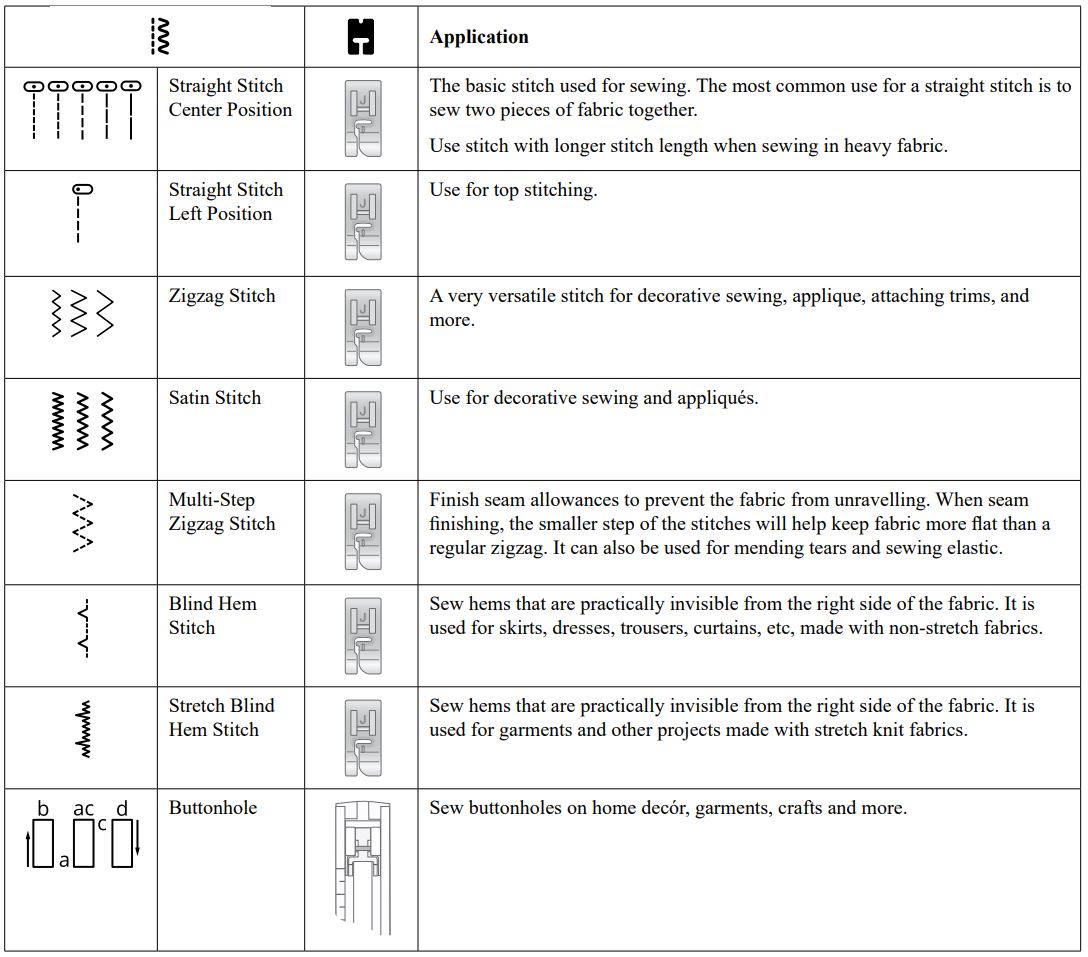
PREPARATIONS
Unpack the Machine
- Place the box on a steady, flat surface. Lift the machine out of the box, and remove the packaging.
- Remove all outer packing material and the plastic bag.
- Wipe off the machine with a dry cloth to remove any lint and/or excess oil around the needle area.
Note: Your sewing machine is adjusted to provide the best stitch result at normal room temperature. Extreme hot and cold temperatures can affect the sewn result.
Connect to the Power Supply
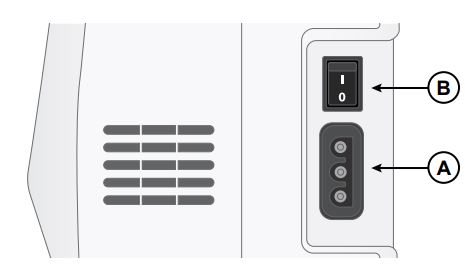
Among the accessories you will find the power cord and the foot control.
For this sewing machine, foot control model HKT7 (110-120V,50/60HZ,2.0A) / HKT72C (GS AX200-240V, 50HZ,0.5A) manufactured by Zhejiang Huaxing Electric Motor Co.,Ltd (China) must be used.
Note: Consult a qualified electrician if in doubt as how to connect the machine to the power source. Unplug the power cord when the machine is not in use.
On the bottom right side of the sewing machine, you find the connecting sockets and the ON/OFF button.
- Connect the power cord to the socket on the bottom right side of the machine (A). Plug the cord into the wall socket.
- Press the ON/OFF switch (B) to “I” to turn on power and light.
Sewing speed is regulated by pressing the foot control.
Note: After turning off the machine, residual power may remain in the machine. This could cause the light to stay on for a few seconds while the power is consumed. This is normal for an energy efficient appliance.
For the USA and Canada
This sewing machine has a polarized plug (one blade wider than the other). To reduce the risk of electric shock, this plug is intended to fit in a polarized outlet only one way. If the plug does not fit fully in the outlet, reverse the plug. If it still does not fit, contact a qualified electrician to install the proper outlet. Do not modify the plug in any way.
Pack Away after Sewing
- Switch the main switch off. After switching off, residual power may still remain in the machine. This may cause the light to stay on for a few seconds while the power is consumed. This is normal behaviour for an energy efficient appliance.
- Unplug the cord from the wall socket and then from the machine.
- Wind the cord around the foot control for easy storage.
- Place all accessories in the accessory tray. Slide the tray on to the machine around the free arm.
- Place the foot control and cord in the space above the free arm.
- Place the soft cover on the machine to help protect it from dust and lint.
Free Arm/Removable Accessory Tray
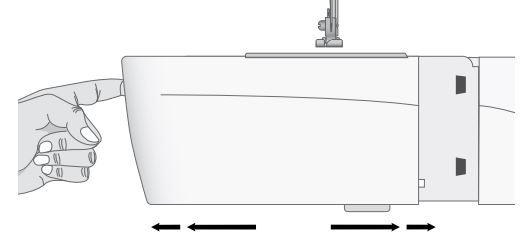
Store presser feet, bobbins, needles and other accessories in the accessory tray so that they are easily accessible. Keep the accessory tray on the machine to provide a larger, flat work surface. Use the free arm to facilitate sewing trouser legs and sleeve hems. To use the free arm, slide off the accessory tray. When attached, a hook keeps the accessory tray securely attached to the machine. Remove the tray by sliding it to the left.
Presser Foot Lifter
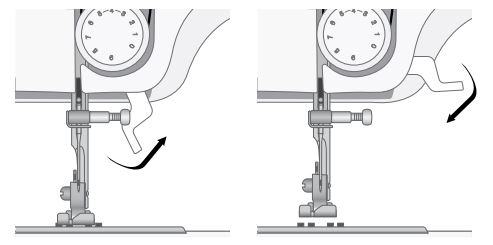
The presser foot lever is located at the side of the sewing machine head. The lever is used to raise and lower the presser foot. Raise the lever up for machine threading, lower it for sewing. When the foot is in the raised position, press the lever further upward for more room under the presser foot. This is good for sewing thick projects.
Thread Knife
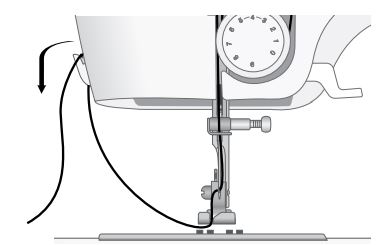
To use the thread knife, pull the thread from back to front as illustrated. Doing this will leave the thread ends long enough so that the needle doesn’t become unthreaded when you start to sew again.
Change the Presser Foot
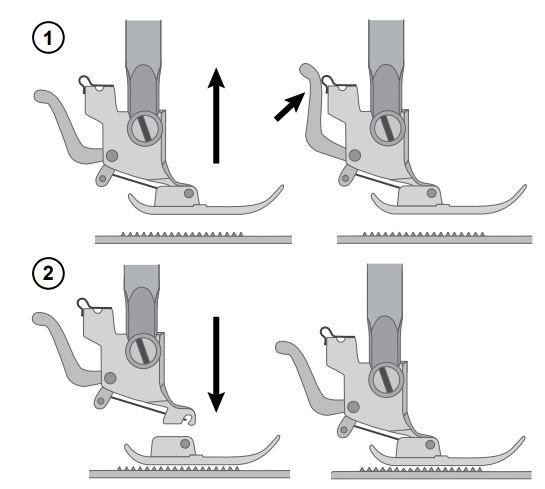
- Make sure that the needle is in the highest position and the presser foot is lifted. The presser foot release lever extends out the back of the presser foot holder. Press this lever to release the presser foot.
- To attach a presser foot to the holder, place the desired presser foot with its pin directly under the slot in the presser foot holder. Lower the presser foot lifter and the presser foot will snap into place.
Note: If you find it difficult to place the presser foot in the correct position, keep the release lever pressed while lowering the presser foot. Use your thumb to carefully guide the presser foot into the correct position and it will snap into place.
Wind the Bobbin
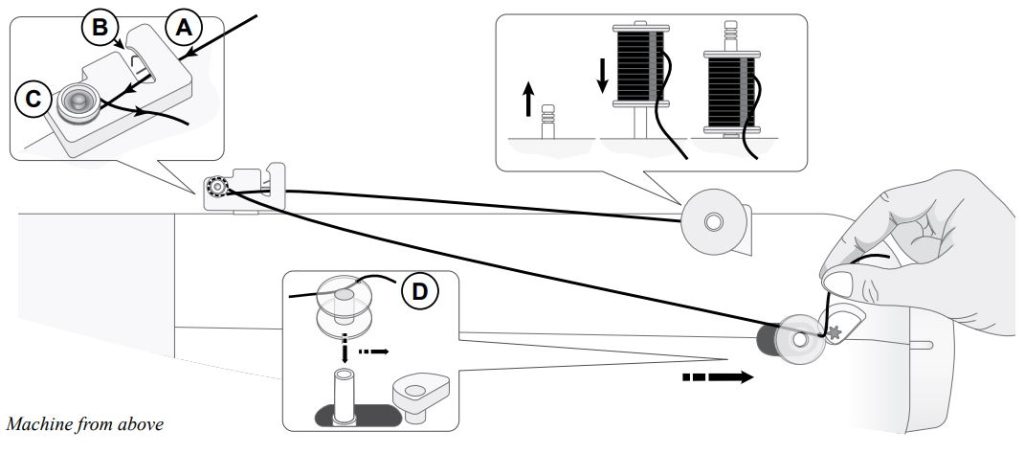
- Pull up the spool pin to its full extent.
- Place a thread spool on the spool pin.
- Place the thread into the thread guide (A) from back to the front. Make sure the threads slips into the spring (B). Bring the thread clockwise around the bobbin winding tension disc (C).
- Thread through the hole in the bobbin (D) from the inside to the outside.
- Place the bobbin on the bobbin winding spindle. Make sure the bobbin is pushed down firmly.
- Push the bobbin winding spindle to the right. Hold the thread end, and press the foot control to start winding. After a few turns, take your foot off the foot control to stop winding. Cut the excess thread tail above the bobbin, making sure to trim it close to the bobbin. Step on the foot control to resume winding. When the bobbin is full, the bobbin winding will slow down.
- Remove your foot from the foot control to stop winding.
- Push the bobbin winding spindle to the left. Remove the bobbin and cut the thread.
Note: When the bobbin winding spindle is pushed to the right, the machine will not sew. Make sure to push the bobbin spindle back to the sewing position (left) before sewing.
Insert the Bobbin
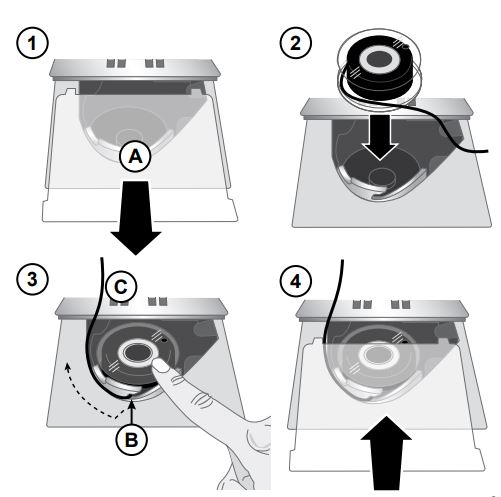
Note: Make sure that the needle is fully raised and the machine is turned off before inserting or removing the bobbin.
- Remove the bobbin cover (A) by sliding it towards you.
- Insert the bobbin in the bobbin case with the thread running in a counter clockwise direction.
- Pull the thread through the slit (B). Pull out about 15cm (6 inches) of thread and place it to the back over the stitch plate (C).
- Attach the bobbin cover plate.
Thread the Machine
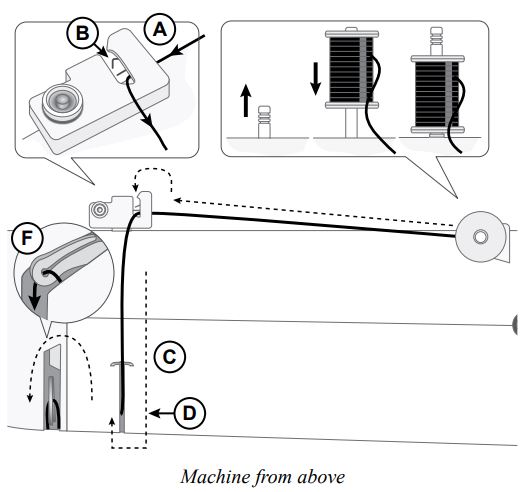
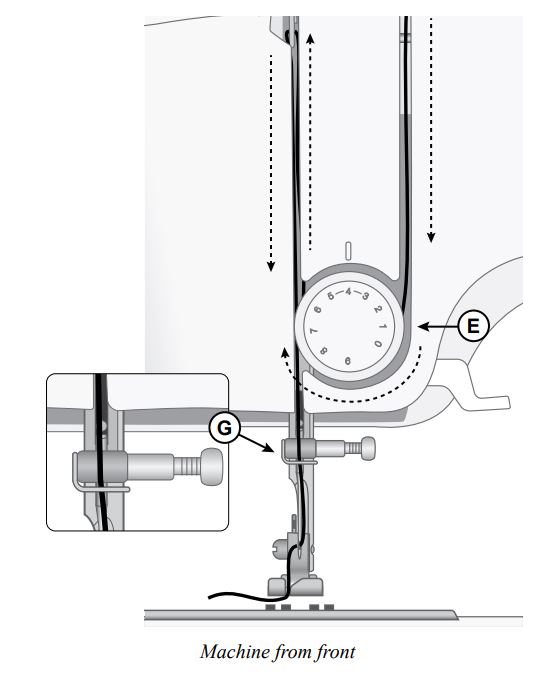
Important! Make sure that the presser foot is raised and the needle is in its highest position by turning the handwheel toward you. This is very important to help ensure that the machine is correctly threaded. Not doing so can result in poor stitch quality when you start to sew.
- Pull up the spool pin to its full extent.
- Place a thread spool on the spool pin.
- Place the thread into the thread guide (A) from back to the front. Make sure the threads slips into the spring (B).
- Pull the thread over the thread guide (C) and down in the threading slot (D).
- Continue bringing the thread down through the right threading slot, around the the tension dial (E) (make sure the thread slips into the tension discs). Then bring the thread back upwards through the left threading slot.
- Bring the thread from the right into the take-up lever (F) and down in the left-hand threading slot, and into the needle thread guide (G).
- Thread the needle from front to back.
Bring Up the Bobbin Thread
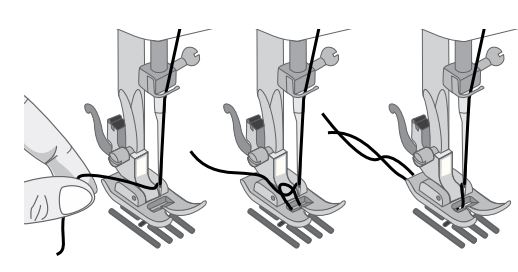
- Hold the upper thread with the left hand. Turn the hand wheel towards you lowering, then raising needle.
- If it is difficult to raise the bobbin thread, check to make sure the thread is not trapped in the bobbin cover.
- Gently pull on the upper thread to bring the bobbin thread up through the needle plate hole.
- Lay both threads to the back under the presser foot. Pull out about 68″ (1520cm) of thread behind the needle.
Needles
The sewing machine needle plays an important role in successful sewing. Use only quality needles. We recommend needles of system 130/705H. The needle package included with your machine contains needles of the most frequently used sizes.

Note: To avoid the needle break, use only medium/low speed and recommended needle on thick fabrics works.
Important Needle Information

Always use a straight needle with a sharp point and make sure the point is not bent or damaged (A).
A damaged needle (B) can cause skipped stitches, breakage or snapping of the thread. It can also damage the needle plate.
Do not use asymmetrical twin needles (C), they can damage your sewing machine.
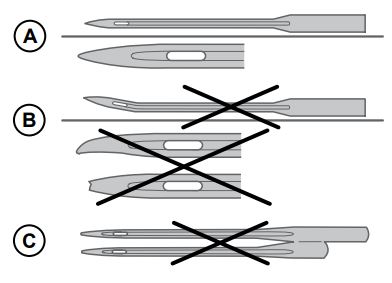
Selection Guide — Needle Size, Fabric, Thread
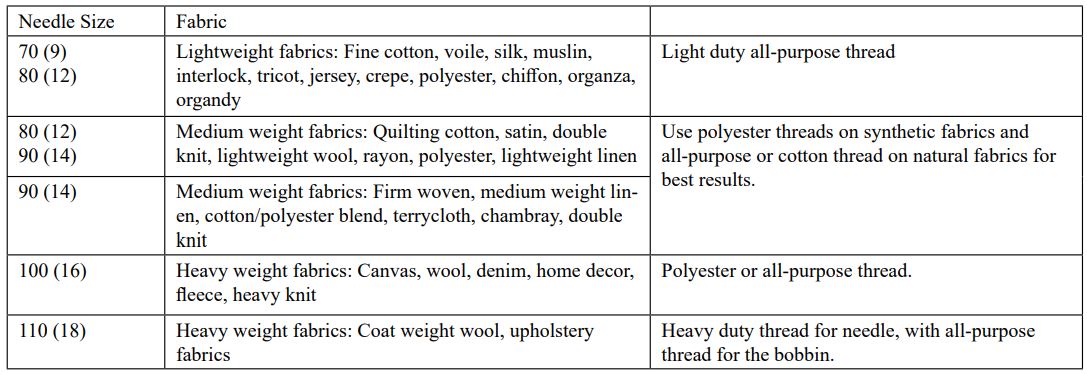
Change the Needle
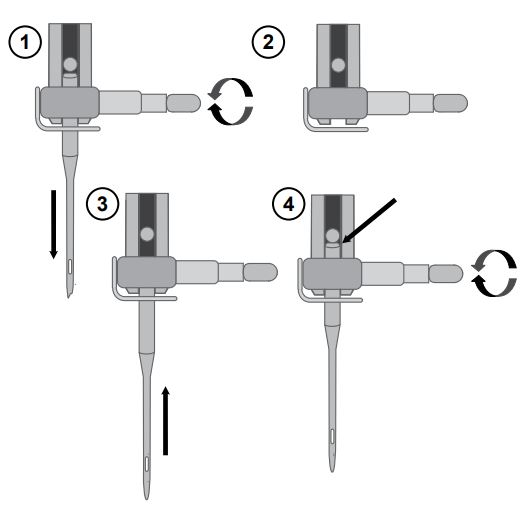
Note: Before you begin changing the needle, it can be helpful to place a small piece of paper or fabric underneath the needle area, over the hole in the needle plate, so that the needle doesn’t accidentally fall down into the machine.
- Loosen the needle clamp screw. If it feels tight, use the screwdriver from your accessories to aid with loosening the screw.
- Remove the needle.
- Push the new needle upwards into the needle clamp with the flat side of the needle away from you.
- When the needle will go up no further, tighten the screw securely.
Thread Tension
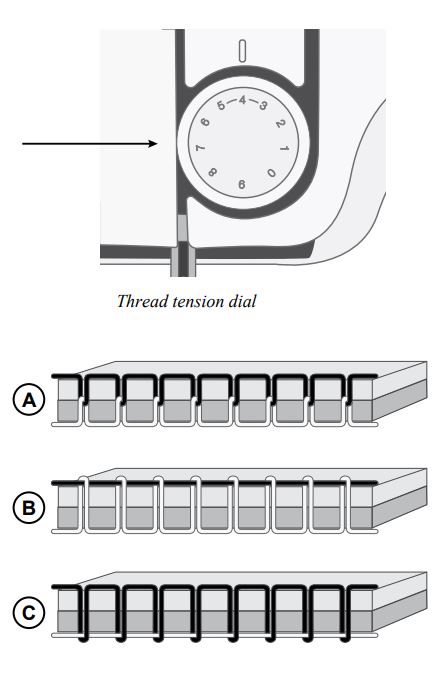
To set the thread tension, turn the dial on the front of the machine. Depending on the fabric, thread, etc, the tension may need to be adjusted. For the best stitch appearance and durability, make sure the needle thread tension is correctly adjusted.
When sewing, use a thread tension between 35
For general sewing, the threads evenly meet between the two layers of fabric (A).
If the bobbin thread is visible on the top side of the fabric, the needle thread tension is too tight (B). Reduce the needle thread tension.
If top thread is visible on the underside of the fabric, the needle thread tension is too loose (C). Increase the needle thread tension.
For decorative stitches and buttonholes, the top thread should be visible on the underside of the fabric.
Make a few tests on a scrap piece of the fabric you are going to sew and check the tension.
Select a Stitch
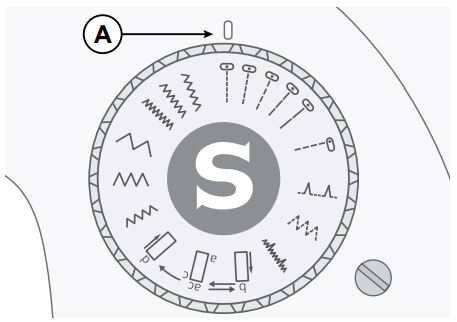
Turn the stitch selector dial to the left or right until the stitch you want to sew is lined up with the dot marking above the dial.
Reverse Sewing
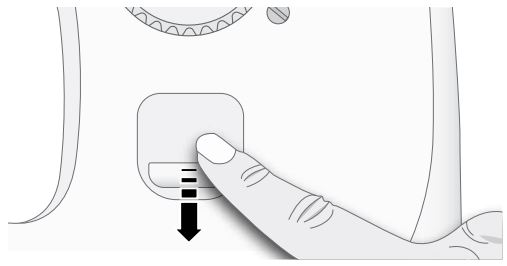
To secure the beginning and the end of a seam, press down the reverse lever. Sew a few reverse stitches. Release the lever and the machine will sew forward again.
SEWING

Next to each stitch or sewing technique described in this section of the manual is a chart showing the recommended settings and presser foot. See sample of the chart to the right.
The recommended settings are also shown on the display, but might need adjustment to fit a special technique.
Note: Some fabrics have a lot of excess dye which can cause discoloration on other fabric but also on your sewing machine. This discolouring may be very difficult or impossible to remove. Fleece and denim fabric in especially red and blue often contain a lot of excess dye. If you suspect that your fabric/ready-to-wear garment contains a lot of excess dye, always pre-wash it before sewing to avoid the discolouring.
Note: For best sewing result, use the same thread on top and bobbin. If sewing with specialty/decorative threads, use regular sewing thread in the bobbin.
Note: When sewing in light weight fabrics, always use stabilizer under the fabric. This is to make sure the fabric feed correctly and that the stitches are formed correctly.
Start to Sew Straight Stitch

Set your machine for straight stitch (see chart to the right).
Raise the presser foot and position the fabric under it, next to a seam allowance guide line on the needle plate or bobbin cover.
Place the top thread underneath the presser foot.
Lower the needle to the point where you want to start. Bring the threads toward the back and lower the presser foot. Press the foot control. Gently guide the fabric along the seam guide letting the machine feed the fabric (A).
Note: Do not forget to bring up the bobbin thread before starting to sew (see page 10.)
To secure the beginning of a seam, press and hold the reverse lever. Sew a few reverse stitches. Release the reverse lever and the machine will sew forward again (B).
Change Sewing Direction
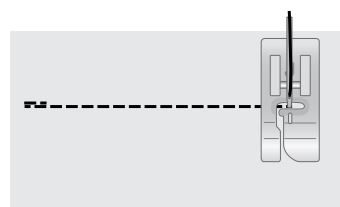
To change sewing direction, stop the machine and turn the handwheel toward you to bring the needle down into the fabric.
Raise the presser foot.
Pivot the fabric around the needle to change sewing direction as desired. Lower the presser foot and continue sewing in the new direction.
Finish Sewing
Press and hold the Reverse lever and sew a few stitches in reverse when you reach the end of the seam. Release the button and sew forward again to the end of the seam. This will secure the seam so the stitches don’t unravel.
Turn the handwheel toward you to raise the needle to its highest position. Raise the presser foot and remove the fabric, pulling the threads to the back.
Pull the threads up and into the thread knife so that the threads are cut the proper length and your needle won’t come unthreaded when you start the next seam.
Multi-Step Zigzag Stitch
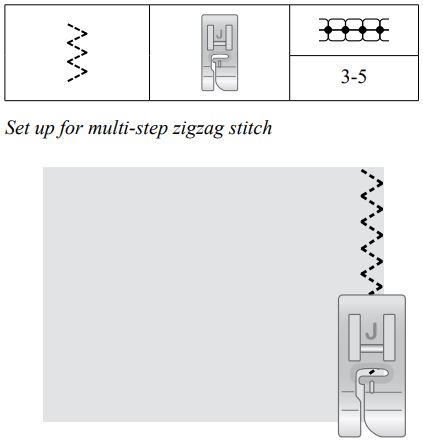
Multi-step zigzag stitch is used to overcast raw edges. Make sure the needle pierces the fabric on the left side and overcasts the edge on the right side.
The stitch can also be used as an elastic stitch to allow seams to stretch when sewing knit fabrics.
Blind Hems

The blind hem stitch is used to make invisible hems on skirts, trousers and home décor projects. There are two types of blind hem; one is recommended for medium to heavy woven fabric (1), the other for medium to heavy stretch fabric (2).
- Finish the raw edge of the hem if sewing on a woven fabric. There is no need to finish the raw edge first on most knits.
- Fold and press the hem allowance to the wrong side.
- Fold the hem back on itself so approximately 3/8″ (1 cm) of the finished edge extends beyond the fold. The wrong side of your project should now be facing up.
- Place the fabric under the presser foot so that the fold runs along the presser foot as illustrated (A).
- When the needle swings into the fold it should catch a small amount of fabric.
Darning and Mending
Repair Large Holes
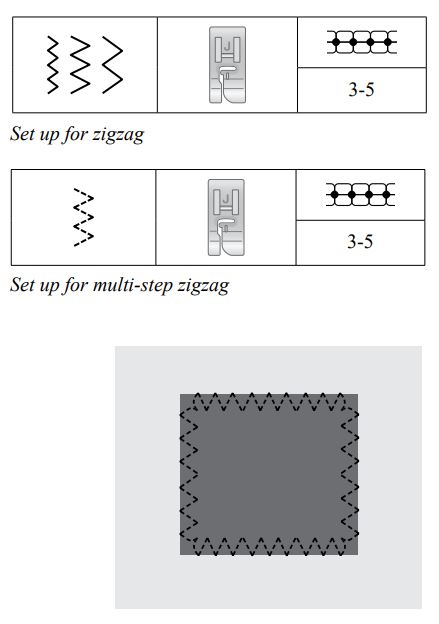
To cover large holes it is necessary to sew a new piece of fabric onto the damaged area.
Baste the new piece of fabric onto the damaged area on the right side of the fabric.
Sew over the fabric edges with the zigzag or the multi-step zigzag stitch.
Trim the damaged area close to the seam from the wrong side
of the fabric. 3-5
Repair Tears

On tears, frayed edges or small holes it is useful to lay a piece of fabric on the wrong side of the fabric. The underplayed fabric reinforces the damaged area.
Lay a piece of fabric underneath the damaged fabric. It must be a little larger than the damaged area.
Sew over the damaged area using the zigzag or multi-step zigzag stitch.
Trim the piece of fabric used as reinforcement.
Four-Step Buttonhole
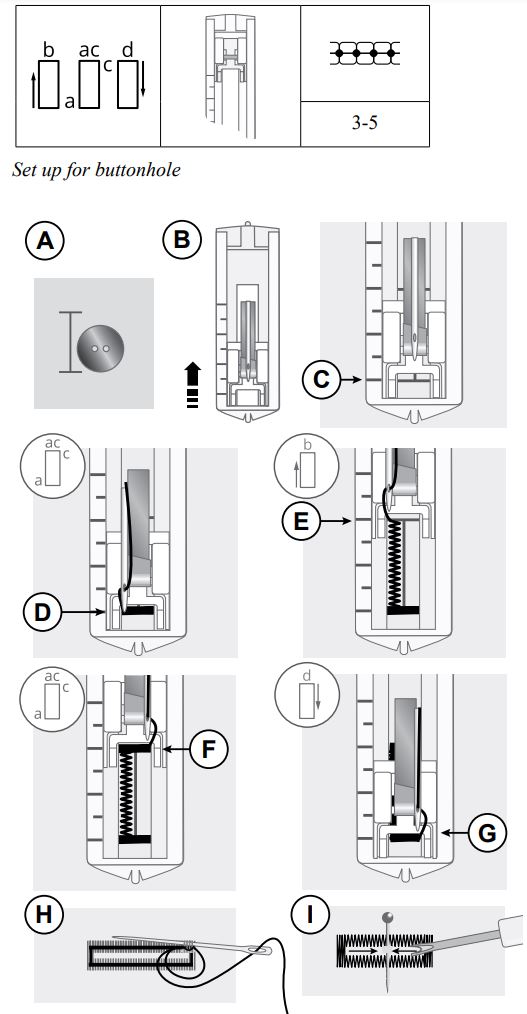
Sew buttonholes perfectly sized for your button. The fabric should be interfaced and/or stabilized where buttonholes are to
be sewn.
- Measure the button to use for your project. Add 5/8 inch (3mm). Use a fabric marking pencil to mark the starting position and length of the buttonhole on the fabric (A).
- Attach the buttonhole foot and slide the foot backwards as far as it will go (B).
- Place the fabric underneath the foot, aligning the marks on the foot with lines marked on the fabric (C).
- Select buttonhole stitch “ac”. Lower the foot and sew 5-6 stitches, to create the first barrack of the buttonhole (D). Stop when the needle is at the left side of the barrack.
- Raise the needle to its highest position and select buttonhole stitch “b”. Sew the left column backwards to the desired length of the buttonhole (E). Stop when the needle is at the left side of the column.
- Raise the needle to its highest position and select button-hole stitch “ac”. Sew the second barrack (F). Stop when the needle is at the right side of the barrack.
- Raise the needle to its highest position and select buttonhole stitch “d”. Sew the right side of the buttonhole to the same length as the first column (G).
- To secure the barrack, thread the end of the top thread into a hand sewing needle, pull to the wrong side and tie the end before cutting excess thread ((H).
- Use a seam ripper and cut the buttonhole open from both ends towards the middle (I).
Note: Always sew a test buttonhole on a piece of scrap fabric.
Buttonhole Balance
If the density of the buttonhole columns differ, you can adjust the stitch density of the buttonhole. The buttonhole balance dial (A) is found on the right side of the stitch selection dial. Only the left column of the buttonhole will be adjusted. Balance it to match the right buttonhole column.
Normally, the dial should be placed in a neutral position (B).
If the stitches of the left buttonhole column are too dense, turn the dial to the left (C).
If the stitches of the left buttonhole column are too sparse, turn the dial to the right (D).
Sew Zippers
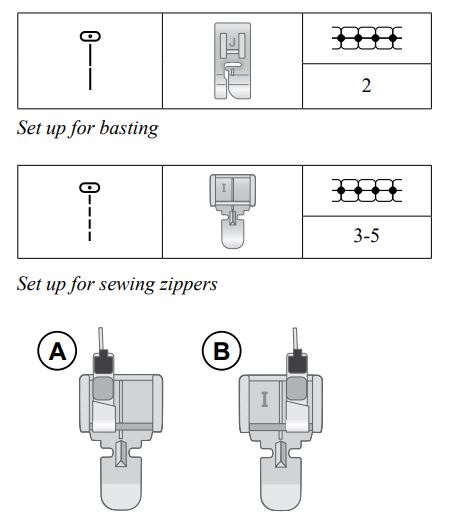
The Zipper Foot can be attached on either the right or the left of the needle, making it easy to sew both sides of the zipper.
To sew the right side of the zipper, attach the foot in the left presser foot position (A).
To sew the left side of zipper, attach the foot in the right presser foot position (B).
Cantered Zipper
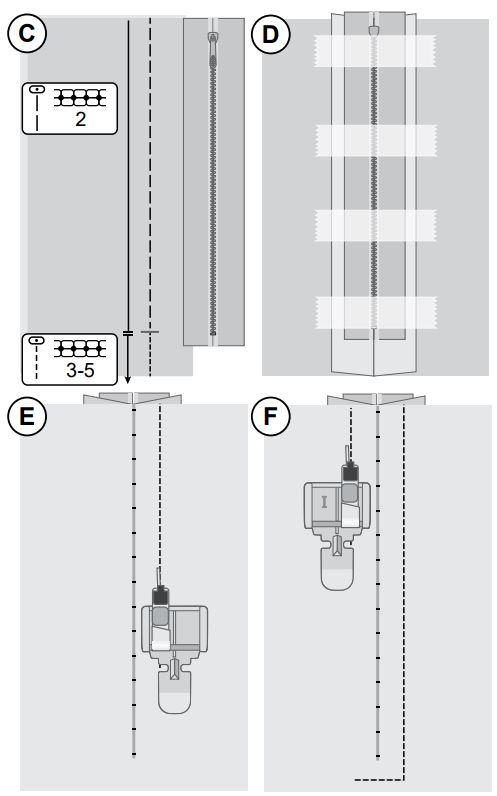
- Place the fabric pieces right sides together and pin. Mark the zipper length on your fabric.
- Baste the zipper seam using the specified seam allowance (use straight stitch with the longest stitch length, thread tension 2). Baste to the end of zipper marking (C).
- Set up the machine for straight stitch (see table above), backstitch a few stitches and sew the rest of the seam using the specified seam allowance (C).
- Press the seam allowances open. Place the right side of the zipper to the wrong side of the seam, tape in place (D).
- Flip your project, making sure that the right side is facing up. Snap on the Zipper Foot, to the left side of the needle (A).
- Sew along the right side of the zipper to the end of your zipper, remember to backstitch in the beginning. Stop with the needle down in the fabric, lift the presser foot and turn your project to sew across the bottom of the zipper (E).
- Attach the Zipper Foot to the right side of the needle (B). Sew the remaining zipper side as you did with the first side
- Flip your project to remove the tape on the back side.
- Flip your project to the right side again and remove the basting stitches.
MAINTENANCE
Cleaning the Machine
To keep your sewing machine operating well, clean it often. No lubrication (oiling) is needed. Wipe the exterior surface of your machine with a soft cloth to remove any dust or lint built up.
Cleaning the Bobbin Area
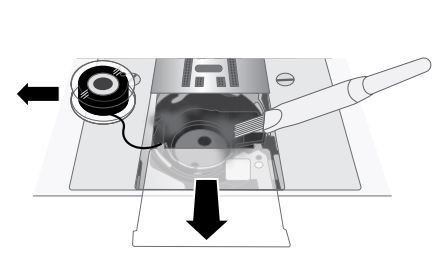

Remove the presser foot. Slide off the bobbin cover and remove the bobbin. Clean the feed teeth and the bobbin area with the brush found among the accessories. Attach the presser foot, insert the bobbin and replace the bobbin cover.
Cleaning under the Bobbin Area
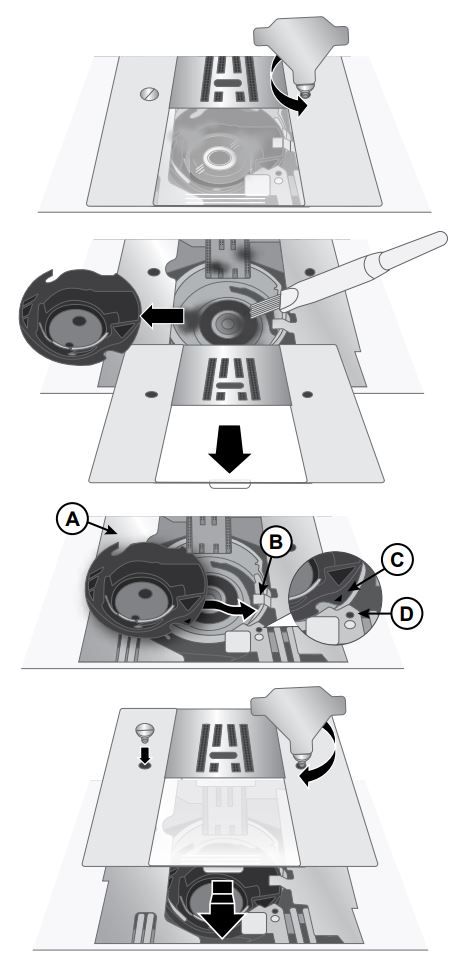

Clean the area under the bobbin case after sewing several projects or any time you notice an accumulation of lint in the bobbin case area.
Remove the presser foot. Remove the screws in the needle plate by using the screwdriver. Lift up and remove the needle plate.
Remove the bobbin case by lifting it up.
Clean the area with the brush or with a dry cloth.
Note: Do not blow air into the bobbin case area. The dust and lint will be blown into your machine.
Guide the “forked” end of the bobbin case (A) under the feed
teeth from left to right. The bobbin case should be placed udder the feed teeth and under the spring (B). The mark (C) on the bobbin case should be aligned with the mark (D) on the the hook race for easy placement. Move the bobbin case slightly until it slips correctly into the hook race (E). To make sure the bobbin case is properly replaced, turn the handwheel towards you. The hook race should rotate freely in a counter-clockwise direction.
Place the needle plate over the feed teeth, replace and tighten the screws.
Attach the presser foot and replace the bobbin.
Troubleshooting
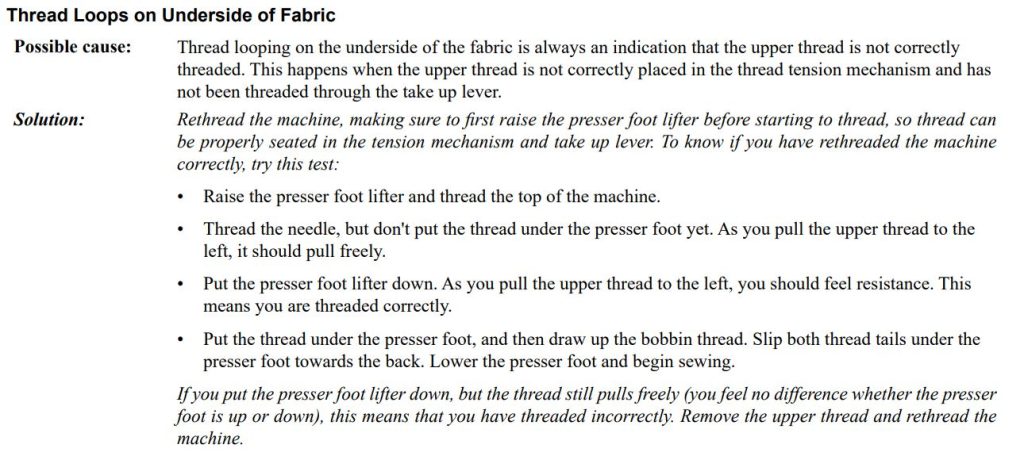



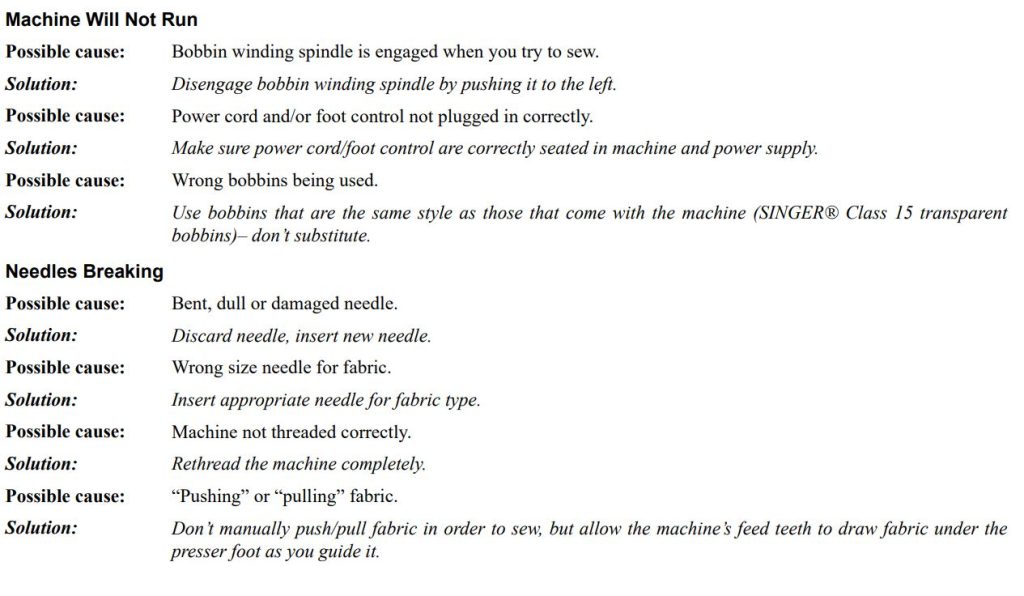

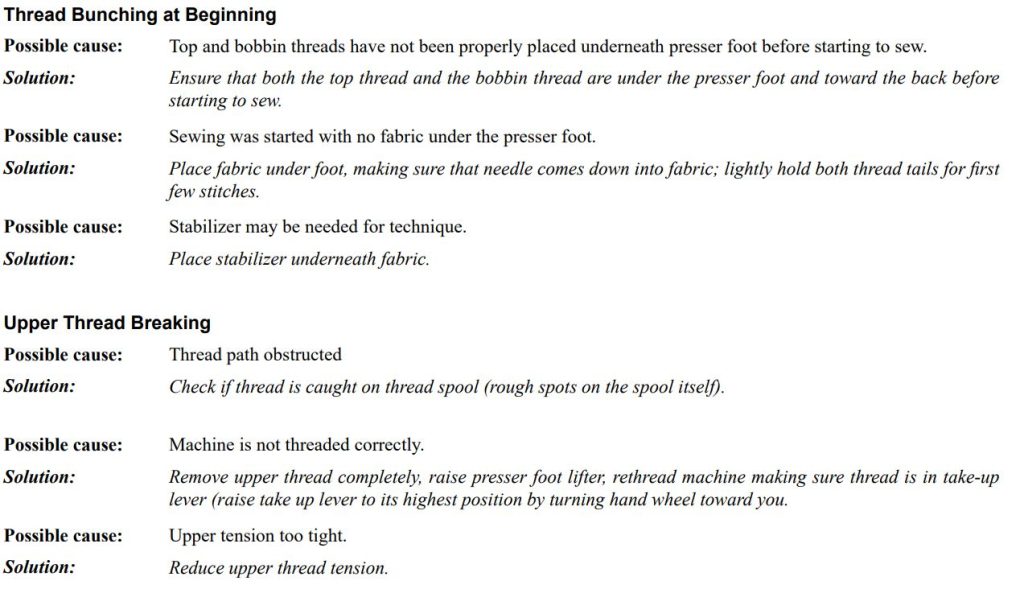
Technical Specification

We reserve the right to change the machine equipment and the assortment of accessories without prior notice, or make modifications to the performance or design. Such modifications, however, will always be to the benefit of the user and the product.
INTELLECTUAL PROPERTY
SINGER, and the Cameo “S” Design, are exclusive trademarks of The Singer Company Limited S.à.r.l. or its Affiliates.
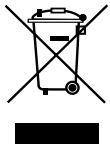
MANUFACTURER
VSM Group AB Soldattorpsgatan 3, SE-55474 Jönköping, SWEDEN
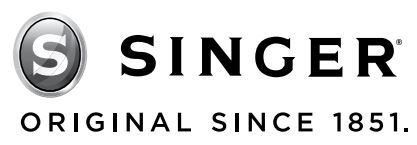
471081526A · English· ©2021 The Singer Company Limited S.à.r.l. or its Affiliates. · All rights reserved · Printed on environment friendly paper

